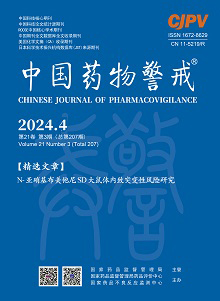|
|
Effect of extracts of Pith-nodecayed and Pith-decayed of Scutellariae Radix on intestinal flora and protective mechanism of intestinal mucosal barrier in damp-heat ulcerative colitis rats
HUANG Wei, LUO Yaqin, YU Xinyang, DONG Hongjing, WANG Xiao
2024, 21(4):
408-414.
DOI: 10.19803/j.1672-8629.20230552
Objective To investigate the effect of extracts from Pith-decayed and Pith-nodecayed products of Scutellariae Radix on intestinal flora and the protective mechanism of intestinal mucosal barrier in rats with damp-heat ulcerative colitis(UC). Methods Fifty healthy SD rats were randomly divided into 5 groups: normal group, model group, Pith-decayed products of Scutellariae Radix group, Pith-nodecayed products of Scutellariae Radix group and mesalazine group, with 10 rats in each group. The damp-heat UC rat model was established by the combination of high-fat and high-sugar diet+high-liquor administration+5% dextran sodium sulfate (DSS). Each group was given intragastric administration on the first day of modeling, respectively. The dosage of Pith-decayed products group and Pith-nodecayed products group was 5.25 g·kg-1·d-1, and that of mesalazine group was 0.266 g·kg-1·d-1. Normal group and model group were given equal volume of normal saline. The drug was administered continuously for 28 days. After administration, sterile feces were collected, and the colonic mucous tissues were dissected and homogenized. The levels of interleukin-6 (IL-6), tumor necrosis factor-α (TNF-α) and interleukin-1β (IL-1β) in colonic mucosa of rats were detected by Elisa. Real-time fluorescence quantitative polymerase chain reaction (qRT-PCR) was used to detect the mRNA expression levels of Claudin-1, MUC2, Occludin, ZO-1 in colon tissue of rats. 16S rDNA sequencing technology was used to detect the quantity and abundance of intestinal flora in stool of rats. Results Compared with normal group, the contents of IL-6, TNF-α and IL-1β in colonic mucosa of rats in model group were significantly increased (P<0.01), and mRNA expression levels of Claudin-1, MUC2, Occludin and ZO-1 were significantly increased (P<0.01). After 28 days of administration, compared with the model group, the levels of IL-6, TNF-α and IL-1β in colonic mucosa of rats in each administration group were significantly decreased (P<0.01), and the mRNA expression levels of Claudin-1, MUC2, Occludin and ZO-1 indexes were significantly decreased in different degrees (P<0.05 or P<0.01). Compared with Pith-decayed products group, Pith-nodecayed products group and mesalazine group were superior to Pith-decayed products group in reducing the levels of IL-6, TNF-α, IL-1β, and mRNA expression of Claudin-1, Occludin, ZO-1 (P<0.05 or P<0.01), but had no significant improvement on MUC2 index. Mesalazine group has the best efficacy. The intestinal flora sequencing results showed that the diversity and abundance of intestinal bacteria in the damp-heat UC model group decreased, and the relative abundance of Firmicutes and Bacteroidota decreased significantly (P<0.05). The relative abundance of Proteobacteria was significantly increased (P<0.05), Firmicutes and Bacteroides were significantly increased in Pith-decayed products group and Pith-nodecayed products group (P<0.05), Proteobacteria was significantly decreased (P<0.05), and mesalazine group had no significant effect on regulating the flora (P>0.05). There was also some difference between Pith-decayed products group and Pith-nodecayed products group. Pith-decayed products group was mainly increased in Firmicutes, while Pith-nodecayed products group was mainly increased in Bacteroidetes. Conclusion Pith-decayed and Pith-nodecayed products of Scutellariae Radix may protect the damaged intestinal mucosal barrier and inhibit the inflammatory response by regulating the unbalanced intestinal flora, and play a role in the treatment of damp-heat UC.
References |
Related Articles |
Metrics
|

